One of my greatest passions is astrophotography, but not just to make
pretty pictures. As John Dobson once told me, "All the good pictures have
already been taken by Kitt Peak." I'm not sure John is totally right.
There is some pretty good stuff out there being done by all kinds of
people, mostly amateurs. Check any link anywhere to see them. My purpose is to get
good enough images to do some real discovery work. Most of that is being done
by the amateurs now and I want to play too. The three areas I am most interested in are:
A supernova is a star, which has reached the end of its life and exploded. Only larger stars
end their existence in this manner. Almost all of the heavier elements in the universe are
thought to come from this catastrophic event. This means all of us and every solid object
around us originated in a super nova at some time in the past. To understand the alchemy of this
creation is to understand the physics of matter itself. When a new super nova is discovered
by an amateur, many of the professional astronomers turn their instruments to it to gather the
data needed to fill the gaps in our understanding of this phenomena. Brendon Downs in Australia
has been doing some of this work and his webpage
gives some insight into what is involved.
There are many asteroids and our discovery and tracking of them may be a matter of survival
of our species. Several mass extinctions on Earth have been attributed to asteroid collisions with the
Earth. The discovery of asteroids and the observations of their positions and orbits is very
important work. Dennis DiCicco has been doing much of this work in Ft. Bend, Texas and his
webpage gives many details of what is
involved.
You just never know what you are going to find when you are looking through a telescope. With CCD imaging that
is even more of a fact. Who would have guessed at the latest accidental discovery of Comet Hale Bopp, for example, the brightest
comet of our century. The simultaneous discovery of this comet by a couple of guys out looking at the stars is one of the most
exciting stories of our time.
Look and Ye Shall Find
You must look to find. I did not want to reinvent the wheel, so I have decided to
go with an instrument system made for this and chose the LX200 telescope from
Meade, the ST7 CCD camera from Santa Barbara Instruments Group, and The Sky software
from Software Bisque. I realize there are other systems out there which work,
but this combination is probably the best supported and offers the fastest path to
immediate productivity at this time. There are lots of places you can go to see
the hardware and software and I will not bore you with those details here. The great thing about it are the user
groups for the LX200 called MAPUG and for the SBIG CCD camera called SBIG. By subscribing
to these news groups you can get copies of about 20 email posting a day between the
users and post your own questions for immediate response from those who have gone before.
Hence, my plans for my backyard setup, my scope camera combo, my software, and much
eager hand holding as I get things set up.
This is about doing science, not taking pretty pictures. It is about making some small contribution
to our knowledge of our universe, of being a resource to others and a contributor to the
body science. Just maybe, if we interconnect our efforts, we will make a difference on a
crazy selfish planet hell bent on its own destruction. Well, so much for philosophy.
The Journey Begins
Here is my progress report on my journey as it begins and progresses.
The day two years ago when I got my LX200 10" F10 I just wanted to learn how to use it.
This was after I learned the sky a little and gained a basic understanding of the current
work. That started long before, about 1984. Since then I have used the little observing
programs of the Astronomical League and the ASKC to get a basic knowledge of astronomy. Reading
helped too. There is really no substitute for joining a local astronomy club
and earning all those observing awards offered by the AL. I have them all except for the
solar and recent Arp and Herschel II, but I will eventually get those too when I feel like it.
I have enough now to start doing science.
The way I have gone after the hardware has been strictly low budget. The LX200 10" I got used
for half new price. I did not get the new software but with The Sky running the scope you really
don't need it. I picked up the ST7 on sale. The rest is hardware. I also always register my
software even the shareware stuff. I just mailed a $10 bill to Jesus Rodriquez in Madrid, Spain for his Field of
View program. What a neat little program. Why not register? Let's encourage people like Jesus to do more.
Small price to pay for genius. I think people who steal software are making a huge Karmic withdrawal
and obviously do not understand the battle between good and evil too well. Ugly!!!! Why do it to yourself?
Air, sunlight, and water should be free, but genius is precious and should be rewarded to make more of it. Besides, would you steal from Jesus?
Gez, listen to me. More philosophy. Boring!!!!
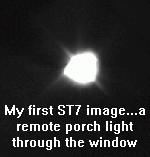 On December 29, 1997, since it was cloudy, my first image with my new CCD was shot through my LX200 10" at F10 from my breakfast nook. I was so
excited I set the LX200 up right there in the house, plugged in my ST7 and pointed it out the
window, through the open blinds, through the tree limbs in the backyard and focused on a porch light on
a remote house four blocks away. Then I started focus shots till I had a decent image. Here it is. Not
bad considering the lights in the kitchen and living room were on bright enough to read the fine print
on the operation of the ST7 while I was making the shot. Guess those two street lights shining in my backyard aren't going to
really be a problem after all, huh?
On December 29, 1997, since it was cloudy, my first image with my new CCD was shot through my LX200 10" at F10 from my breakfast nook. I was so
excited I set the LX200 up right there in the house, plugged in my ST7 and pointed it out the
window, through the open blinds, through the tree limbs in the backyard and focused on a porch light on
a remote house four blocks away. Then I started focus shots till I had a decent image. Here it is. Not
bad considering the lights in the kitchen and living room were on bright enough to read the fine print
on the operation of the ST7 while I was making the shot. Guess those two street lights shining in my backyard aren't going to
really be a problem after all, huh?
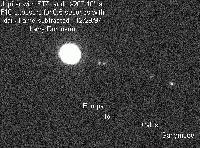 The next night, December 30 was clear and cold so I set my scope up on the tripod in the backyard and took some
shots of Jupiter and Saturn. These pictures were good enough to see the moons of both planets. Later I checked my
recent issue of Sky and Telescope magazine for this date and identified the moons I had imaged. Cool!!! I have a long ways to go before I am
able to make planetary pictures as good as Dr. Parker's but remember the mission!
The next night, December 30 was clear and cold so I set my scope up on the tripod in the backyard and took some
shots of Jupiter and Saturn. These pictures were good enough to see the moons of both planets. Later I checked my
recent issue of Sky and Telescope magazine for this date and identified the moons I had imaged. Cool!!! I have a long ways to go before I am
able to make planetary pictures as good as Dr. Parker's but remember the mission!
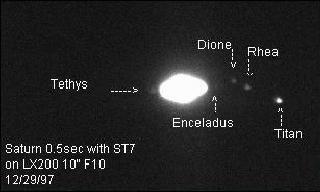
I took a few deep sky images that night and then shut things down when the clouds
rolled in. Yuk! Kansas has lots of clouds. The next night was clear and I did lots of deep sky stuff
just to test the rig. I got the Crab nebula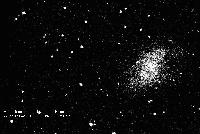
and even imaged the moon a little.
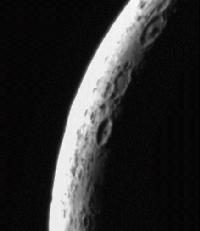
My most interesting image was this one I took of a UFO in Orion.
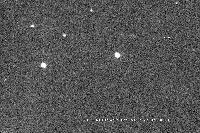
On January 8 I headed for Arizona and will spend a couple of nights over the weekend on
Kitt Peak imaging with their LX200/ST7 setup and learning from them. This is
part of their advanced observing program. I have posted the report on
our trip at the newKitt Peak Page
UPDATE
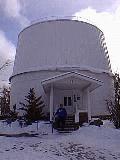 Yesterday, January 11, I drove up to Flagstaff with a couple of friends and visited Lowell Observatory and got the guided tour
on Mars Hill. I got to actually touch the 24" Alvyn Clark Refractor used by Percival Lowell and the Schmidt camera used by Clyde Tomball to image
his dicovery plates of Pluto. What a wonderful tour. They have a new 16" telecope and dome, which they use for their public nights. They have a new
observing program where you can use all the telescopes on the hill to observe and the cost is only $95 per night. They will also have
CCD imaging on the 16". Looks like a little competition for Kitt Peak.
Yesterday, January 11, I drove up to Flagstaff with a couple of friends and visited Lowell Observatory and got the guided tour
on Mars Hill. I got to actually touch the 24" Alvyn Clark Refractor used by Percival Lowell and the Schmidt camera used by Clyde Tomball to image
his dicovery plates of Pluto. What a wonderful tour. They have a new 16" telecope and dome, which they use for their public nights. They have a new
observing program where you can use all the telescopes on the hill to observe and the cost is only $95 per night. They will also have
CCD imaging on the 16". Looks like a little competition for Kitt Peak.
One interesting story is that on the morning after the Mars meteor fossil life announcement, one of the Lowell Observatory guides found a bottle of champagne on the steps
of Percival Lowell's tomb.
A cold night's work
Friday night, January 23, the temperature dipped down to close to zero, but it was clear.
I set up the LX200 on the patio and spent the entire night imaging with the ST7. This time
I had the Sky software to help find objects and got it working with the telescope. The results were
fairly satisfying for short exposure times. My alignment on the tripod is still not precise enough
to do any guiding, but I could get some good 30 second exposures which came out well when processed
with CCDSoft. Among the many images I took a few are worth sharing:
M46
M65
M66
NGC3628
M105
Later on I got a little better.
The Antennae
M51
M63
The Triffid
For more CCD images and new information about my set up, go to
More CCD
Back Home
PS:The title of the background music if you are hearing it is "Stairway to Heaven"
 On December 29, 1997, since it was cloudy, my first image with my new CCD was shot through my LX200 10" at F10 from my breakfast nook. I was so
excited I set the LX200 up right there in the house, plugged in my ST7 and pointed it out the
window, through the open blinds, through the tree limbs in the backyard and focused on a porch light on
a remote house four blocks away. Then I started focus shots till I had a decent image. Here it is. Not
bad considering the lights in the kitchen and living room were on bright enough to read the fine print
on the operation of the ST7 while I was making the shot. Guess those two street lights shining in my backyard aren't going to
really be a problem after all, huh?
On December 29, 1997, since it was cloudy, my first image with my new CCD was shot through my LX200 10" at F10 from my breakfast nook. I was so
excited I set the LX200 up right there in the house, plugged in my ST7 and pointed it out the
window, through the open blinds, through the tree limbs in the backyard and focused on a porch light on
a remote house four blocks away. Then I started focus shots till I had a decent image. Here it is. Not
bad considering the lights in the kitchen and living room were on bright enough to read the fine print
on the operation of the ST7 while I was making the shot. Guess those two street lights shining in my backyard aren't going to
really be a problem after all, huh?
 The next night, December 30 was clear and cold so I set my scope up on the tripod in the backyard and took some
shots of Jupiter and Saturn. These pictures were good enough to see the moons of both planets. Later I checked my
recent issue of Sky and Telescope magazine for this date and identified the moons I had imaged. Cool!!! I have a long ways to go before I am
able to make planetary pictures as good as Dr. Parker's but remember the mission!
The next night, December 30 was clear and cold so I set my scope up on the tripod in the backyard and took some
shots of Jupiter and Saturn. These pictures were good enough to see the moons of both planets. Later I checked my
recent issue of Sky and Telescope magazine for this date and identified the moons I had imaged. Cool!!! I have a long ways to go before I am
able to make planetary pictures as good as Dr. Parker's but remember the mission!




